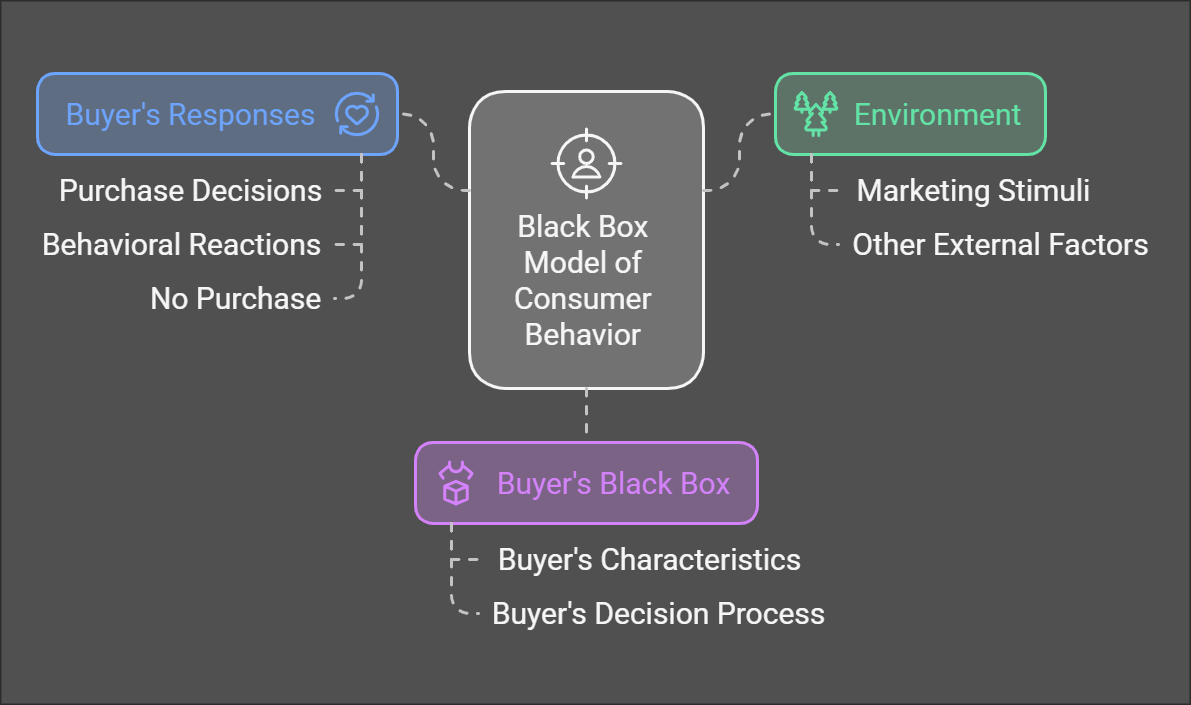Consumer Behavior Model (Black Box)
Consumer Behavior Model (Black Box)
Definition of Consumer Behavior
Consumer behavior is the study of individuals and groups to understand the process they follow before making a purchase. It encompasses psychological, social, and cultural factors that influence decision-making.
According to Engel, Blackwell, and Mansard:
"Consumer behavior is the actions and decision processes of people who purchase goods and services for personal consumption."
Black Box Model of Consumer Behavior
The Black Box Model explains how external stimuli are processed in the consumer's mind (referred to as the "black box") to result in a purchase decision or response. It focuses on three main components:
- Environment
- Buyer's Black Box
- Buyer's Responses
1. Environment
The environment includes external factors that influence consumer behavior.
Marketing Stimuli
- Product: Refers to the features, quality, and design of a product that make it desirable.
- Price: The monetary cost of the product and how it aligns with perceived value.
- Place: The channels through which a product is distributed and its availability.
- Promotion: Advertising, discounts, or other marketing tactics used to attract consumers.
Other External Factors
- Economic Factors: Consumer income, inflation, and market conditions that affect buying capacity.
- Technological Factors: Innovations that improve product appeal, accessibility, or functionality.
- Political Factors: Laws, government policies, and trade regulations that impact the market.
- Cultural Factors: Shared beliefs, traditions, and norms influencing what consumers prioritize.
- Social Factors: Influence from social circles such as family, friends, and communities.
2. Buyer's Black Box
The buyer's black box represents the internal mental processes that drive decisions. It includes two primary aspects:
(a) Buyer's Characteristics
- Beliefs and Attitudes: The ideas and feelings a consumer holds about a product or service.
- Values and Motivations: The internal drivers such as aspirations, goals, or desires that shape decisions.
- Knowledge and Perceptions: What consumers know about a product and how they perceive its usefulness.
- Lifestyle: The way consumers live, their habits, and preferences, which impact their choices.
3. Buyer's Responses
The buyer's responses are the observable outcomes of the internal decision-making process.
Purchase Decisions
- Consumers decide what product to buy, which brand to choose, and where to make the purchase.
Behavioral Reactions
- Post-purchase behavior includes loyalty to the brand, switching to another brand, or experiencing buyer’s remorse if the product does not meet expectations.
No Purchase
- Sometimes, the consumer may decide not to buy at all if the product fails to align with their needs, budget, or expectations.
Summary of the Black Box Model
The Black Box Model provides a structured way to analyze the interaction between external stimuli, internal decision-making processes, and observable buyer responses. It helps marketers understand consumer behavior and create strategies to influence purchasing decisions effectively.


No Comments